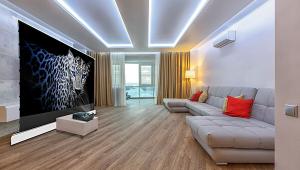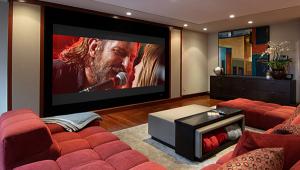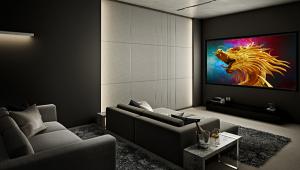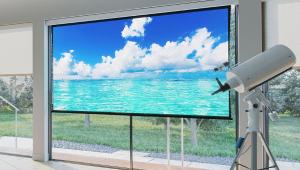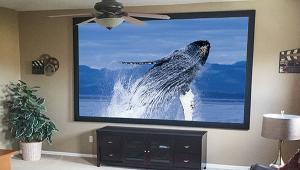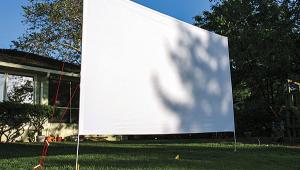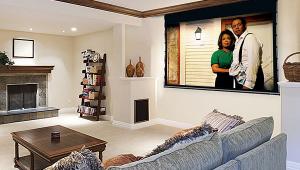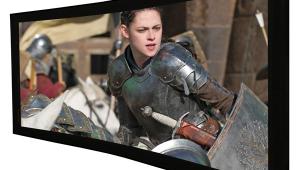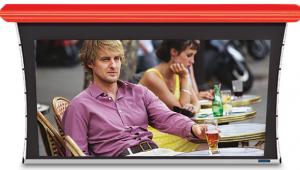Screen Innovations Slate Projection Screen
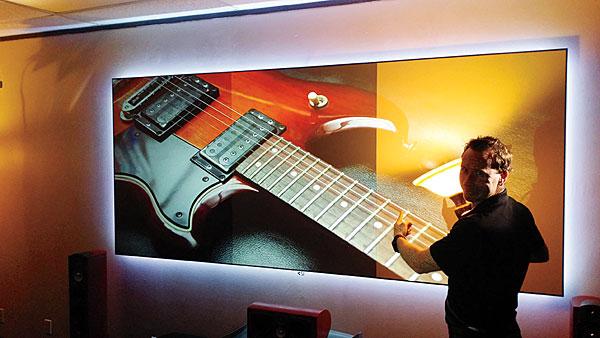
AT A GLANCE
Plus
Superb color and contrast with room lights out
Lights-on viewing can be more satisfying than with
a conventional screen
Minus
Don’t expect miracles: Lights-out viewing still offers a superior picture
THE VERDICT
No screen can provide a projector’s best performance in normal room lighting, but the Screen Innovations Slate takes aim at this goal and, though not scoring a bull’s-eye, comes closer than most.
The surest route to realizing a knockout, big-picture home theater is to install a separate projector and screen. Once you’ve experienced it, you’ll wonder how you were ever satisfied with a “tiny” flat-screen HDTV.
Up until a few years ago, the biggest obstacle to realizing that ideal was the price of a good projector. Today, however, you can buy an excellent projector for under $3,000, and although that’s not chicken feed, it’s within the reach of many serious home theater enthusiasts. But what was once a secondary stumbling block is now front and center: the need for a fully darkened room to wring the best performance out of that projector. With most projection screens, there’s little choice, and this has kept home projection a niche market.
Screens and Light
Projection screens generally aren’t choosy. Any light that hits them can be reflected back at the viewer. When the light comes from the projector, that’s all well and good. But when it comes from other sources—whether artificial or from an uncovered window during the day—it washes out the picture, either subtly or enough to make viewing impossible.
Efforts to minimize this problem began with rear projection, not only in the now archaic one-piece rear-projection sets but also with a separate projector positioned behind specially designed rear-projection screen material. In the latter arrangement (a sort of DIY rear-projection set, though usually with a much larger screen), the projector can be mounted either on a stand designed for this purpose (with a mirror to allow for a shortened throw distance) or in an adjoining room, with the screen positioned in a hole in the wall between that projection room and the viewing space.
One of the ways in which either type of rear projection can help minimize the effect of ambient light is to reject (as much as possible) light arriving at the screen from directions other than the projector’s. While this results in some sacrifice in brightness when the picture is viewed significantly off center, it soon dawned on the industry that such controlled directivity, often combined with a gray (rather than white) screen, could do the same light-rejection trick for front projection. Today, a leading player in this market—perhaps the leading player—is Screen Innovations.
SI’s premier product is its Black Diamond screen, available in three different gains. But the Black Diamond is expensive compared with more conventional screens of the same size. Enter the Screen Innovations Slate. Medium gray in color, with a specified gain of 1.2, it’s available in many configurations—including fixed with a conventional frame (SI’s so-called Reference frame), motorized, Zero Edge (SI’s name for its near-frameless, non-retractable design), and curved fixed frame. You can also order a range of aspect ratios, including the most commonly used 16:9, 2.35:1, or 2.40:1. The Slate isn’t available micro-perforated to pass audio from behind-the-screen speakers, however. The $2,049 price tag at the top of this review is for a non-curved, 16:9, 96-inch-wide (110-inch-diagonal) Reference fixed-frame model. It was mounted on a stand that was provided for our temporary test setup. (The stand isn’t included in the price, as most fixed screens are wall-mounted.) In the same size, the Zero Edge will run you $2,698, and a motorized $3,899. In contrast, a similar size Black Diamond 1.4 Zero Edge costs $3,699, and a Black Diamond 1.4 motorized $8,000 (ulp!).
We were offered a Zero Edge for this review, but that model is assembled at the factory and shipped in a “pizza box” big enough for a feast for the Jolly Green Giant and his family. Instead, we opted for the Reference fixed-frame model, which in addition to being cheaper than the Zero Edge, arrived in more manageable boxes. SI’s conventional fixed-frame screens are rather different from most other screens we’ve reviewed. They’re stretched onto the frame with small rubber bands, instead of the thumb-a busing clips that, for example, Stewart Filmscreen uses. But for many of you, who will lean on your dealer to handle the setup of any large screen (a smart idea, since screens are easily marred or otherwise damaged), this should be irrelevant.
Performance
I conducted the testing of the Slate screen at our video studio. One disadvantage of this space for such a test is that the studio’s walls, floor, and ceiling are all—by design—a very dark gray. This means that any light source undergoes minimum reflections, unlike the situation in most home environments.
- Log in or register to post comments
